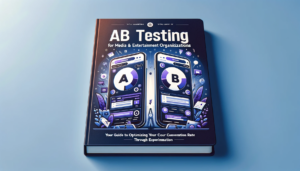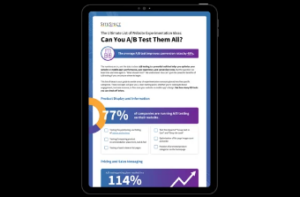Client-Side vs. Server-Side A/B Testing: Is One Better than the Other?
By Mike Fradkin
November 7, 2023
Share
In the world of web development and conversion optimization, the debate between client-side and server-side takes center stage when it comes to A/B testing and experimentation.
But there’s been a lot of confusion and questions surrounding these two approaches. Which one is right for my organization? Is one really better than the other? Could both work together in unison?
In this blog, we’ll bring clarity to these questions by looking at A/B testing with client-side and server-side architectures. We’ll dive into both pros, cons, and use cases of each to give you the full picture. Whether you’re a marketer, developer, product manager, or CRO specialist—let’s dive in and see what you can stand to gain from these approaches to A/B testing and experimentation.
Understanding Client-Side A/B Testing
Client-side A/B testing is your go-to technique if you want to experiment with new design elements or change copy and banners on your site.
Historically, A/B testing began with client-side due to its quick implementation and the ability for less technical users to manipulate and test different look-and-feel elements.
This makes it great for marketers (or non-technical personnel) who want to make changes directly within the web browser. With client-side testing, you can see the results of your alterations in real time. The beauty of this approach lies in its immediacy, allowing you to quickly assess the effectiveness of your changes and make necessary adjustments on the fly. It does, however, quickly expose its limitations.
Pros of client-side testing:
- Client-side platforms are quicker and easier to implement and learn
- Variations and tests can be set up quickly and easily tweaked, even by less technical users.
- Almost all client-side platforms offer an easy-to-use Visual Editor.
- For organizations that are new to A/B testing, it’s a great way to learn about the people/process/tech.
Cons of client-side testing:
- The elements of user experience that can be tested are often limited to look, feel, and copy. More advanced things like checkout flow, search results & algorithms, payment options, and pricing/shipping thresholds can’t be easily tested.
- Almost all client-side tools (though not SiteSpect) use Javascript tags which add noticeable latency and can cause a flicker effect when loading A/B variations.
- Almost all client-side tools (though not SiteSpect) are impacted by today’s current and growing default browser privacy settings.
- Javascript Tags can sometimes lead to the “flicker effect” with less-than-ideal A/B testing solutions.
- The combination of browser privacy settings, latency, and Javascript tag misfires provides less accurate data in client-side A/B tests than with server-side tests.
From testing button colors to headline wording, client-side A/B testing is ideal for fine-tuning small, immediate changes. Let’s take a look at some real-world use cases:
Optimizing Website Design and Layout: You can test different color combos to see which one elicits more user engagement or conversions. These tests help you refine the visual appeal of your website to enhance the user experience.
Call-to-Action (CTA) Testing: You can experiment with CTA text, size, color, and placement to determine which version generates the best results. This approach helps boost click-through rates and conversions.
Content Testing: Content is king in the digital world. With client-side A/B testing, you can experiment with various content elements, such as headlines, product descriptions, and callout text.
Image and Multimedia Testing: You can test different product images to see which ones lead to higher conversion rates. This can be especially valuable for e-commerce sites and those focused on visual storytelling.
Form Optimization: You can experiment with the number of form fields, their order, and the overall usability of the form. The goal is to streamline the process and reduce user drop-offs.
Navigation and Menu Testing: The structure and navigation of a website can significantly impact user engagement. Client-side A/B testing allows you to test different menu layouts, navigation paths, and site structures to identify the most user-friendly configuration.
Product Recommendations: A/B testing can also be used to deliver tailored product recommendations based on visitor behaviors. This gives you the advantage of testing and validating the impact of your recommendations to deliver a more personalized experience overall.
At SiteSpect, our client-side A/B testing solution stands out by providing ease of use and quick iterations without the slowness and flickers that plague the users’ experience. We eliminate the disruptive website “flicker” effect that plagues JavaScript tag-based alternatives by sitting in the flow of traffic.
Now, let’s shift gears and take a look at server-side A/B testing.
Breaking Down Server-Side A/B Testing
Server-side A/B testing, in contrast to its client-side counterpart, takes place on web and application servers rather than in a user’s browser.
It involves making changes at the server level before the user’s browser receives the content. This means that users interact with the updated content without their browsers being aware of the changes. It allows for going beyond look and feel and digs into features, functionality, and algorithms to the website; encompassing elements that can’t be handled on the client-side alone.
Server-side A/B testing empowers developers, product, and user experience teams with the ability to test and optimize more complex parts of a site that only occur at the server level. Examples of these might be search optimization, testing 3rd party services like address validation or taxation, testing alternate app platforms and origins, and optimizing product recommendation algorithms.
Pros of server-side testing:
- Enable A/B testing and experimentation that goes beyond the look and feel, and dives into features and functionality that truly impact your business
- Reduce the risk of introducing new features and releases
- Removes the latency, data accuracy, and flicker concerns outlined above in the client-side “cons” section
- Offers developers full control over the testing program
Cons of server-side testing:
- Changes and tests usually have to be rolled out as part of larger code releases.
- Almost always requires development skills, so
- Far less accessible to marketers and less technical folks.
- Adds burden to development teams that may already be saturated with other pressing work and roadmap items.
- Moves the setup and execution of A/B testing to higher-paid resources which may impact costs.
- Can make smaller or more short-lived changes harder to justify.
- Tends to de-prioritize and slow down some of the things marketing may want to change and test.
- Depending on the test, immediate tweaks are not always possible.
For large-scale changes or backend optimizations, server-side A/B testing takes the lead. Let’s take a look at some actionable use cases:
E-commerce Platform Optimization: Websites often deal with complex back-end processes, such as inventory management, payment gateways, and product recommendations. Server-side A/B testing can optimize these processes, improving the user experience, increasing conversions, and boosting sales. Some testing examples include free shipping thresholds, payment options, alternate checkout flows, and different pricing models.
User Experience Improvements: You can test the impact of site speed optimizations, such as lazy loading images or improving the overall responsiveness of your website. These improvements contribute to a positive user experience, which is critical for retaining and satisfying visitors.
Security Enhancements: Websites handling sensitive data, such as financial institutions and healthcare providers, can use server-side A/B testing to test and strengthen security measures in authentication processes, data encryption, and intrusion detection systems.
Multi-Platform Consistency: Server-side A/B testing is valuable for ensuring consistent user experiences across various devices and platforms. This is essential for websites with extensive mobile, desktop, and app user bases.
As you can see, server-side A/B testing is a powerful tool for web developers, offering the ability to control, optimize, and secure a website’s core functionalities. While its setup and execution may not be as easy and quick as client-side testing, it opens up a whole set of valuable use cases that client-side simply cannot touch.
The BIG Problem with Choosing a Winner
At the beginning, we asked which is better: client-side or server-side? By now, you’ve probably realized what many organizations have realized in the last few years: you need both in order to be competitive. With that said, there’s still one problem we need to consider.
Many A/B testing platforms do not offer a unified approach that seamlessly combines both client-side and server-side solutions under the same user interface. This fragmentation of testing methodologies creates a substantial barrier to achieving a cohesive and effective A/B testing strategy.

Marketers and non-technical users are stuck on the side of client-side testing, while engineers and developers remain on the server-side testing side.
The BIG problem is that without a unified solution, organizations are often forced to grapple with a disjointed testing environment. They might employ one platform for client-side testing and another for server-side testing, leading to overlap and operational inefficiencies, increased complexity, and a lack of synchronization between the two approaches. This not only complicates the testing process but can also hinder your organization’s innovation by adding barriers to collaboration.
So, what’s the solution to this BIG problem?
SiteSpect: Bridging the “Great Divide”
SiteSpect stands out by addressing this “great divide,” offering a single, integrated user interface that seamlessly combines client-side and server-side A/B testing and personalization capabilities.
Our approach to breaking down the silos encourages collaboration and gives access to…
…teams so they can implement and test all necessary use cases in support of your business. This not only streamlines the testing process but also ensures a consistent and coordinated approach, enabling organizations to make data-driven decisions and deliver exceptional user experiences without the hindrance of siloed solutions.

This end-to-end approach means your teams can test the small, simple look and feel items to larger, more complex backend changes
- Text, images, CTAs, layouts
- Search algorithms, free shipping thresholds
- Pricing, checkout processes, payment options
- Form completion, engagement
- Single page apps, dynamic content
- Vendor and platform comparison
Plus, our users can also leverage our personalization, Product Recommendations, and analytics features. All under one unified platform!
Final Thoughts
No longer is there a need to compromise by choosing one over the other; SiteSpect’s integrated approach allows organizations to leverage the strengths of both client-side and server-side testing. This is how we transcend the “Great Divide” and enable your organization to innovate and take A/B testing to new heights.
Our advanced platform gives you the best of both worlds. Request your free SiteSpect demo to see how client-side and server-side can help your organization.
One platform. One Setup. One all-encompassing A/B testing solution.
Share
Suggested Posts
Subscribe to our blog:






